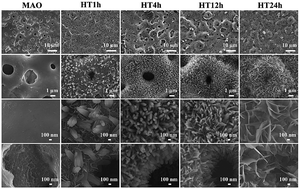Titanium-based implant comprising a porous microstructure assembled with nanoleaves and controllable silicon-ion release for enhanced osseointegration
Abstract
Osseointegration is crucial for early fixation as well as for long-term implantation success, hence numerous efforts have been made to tune the surface topography or chemical composition of biomedical implants to improve osseointegration. In this work, various nanostructures, including nanoflocs, nanobundles, nanorods, and nanoleaves, were introduced to the surface of silicon (Si)-incorporated microporous structure to form Si-incorporated micro–nano hierarchical structures on titanium (Ti)-based implants. The osseointegration of the implants were systemically assessed in vivo and in vitro. The in vitro evaluations showed that the nanostructures promoted the protein adsorption, thus modulating the early cellular responses, including the attachment and spreading of osteoblasts and human endothelial cells (HUVECs), and subsequent cell proliferation and differentiation. Furthermore, compared with the single microporous structure, the nanostructures located over the microporous structure protected the Si ions from quick release and allowed the long-term sustained Si-ions release, which further contributed to the proliferation and differentiation of osteoblasts and vascular endothelial growth factor (VEGF) secretion as well as the tube formation of HUVECs. Collectively, the favorable nano-surface structures, especially the nanoleaves structure, and the constant Si-ion release together led to robust osteogenic and angiogenic activities. More importantly, in vivo micro-CT evaluation and histological observations further verified that the Si-incorporated micro–nano hierarchical implant with nanoleaves structure could efficiently promote new bone formation, thus indicating it was an attractive candidate as a next-generation bone-implant material.



 Please wait while we load your content...
Please wait while we load your content...